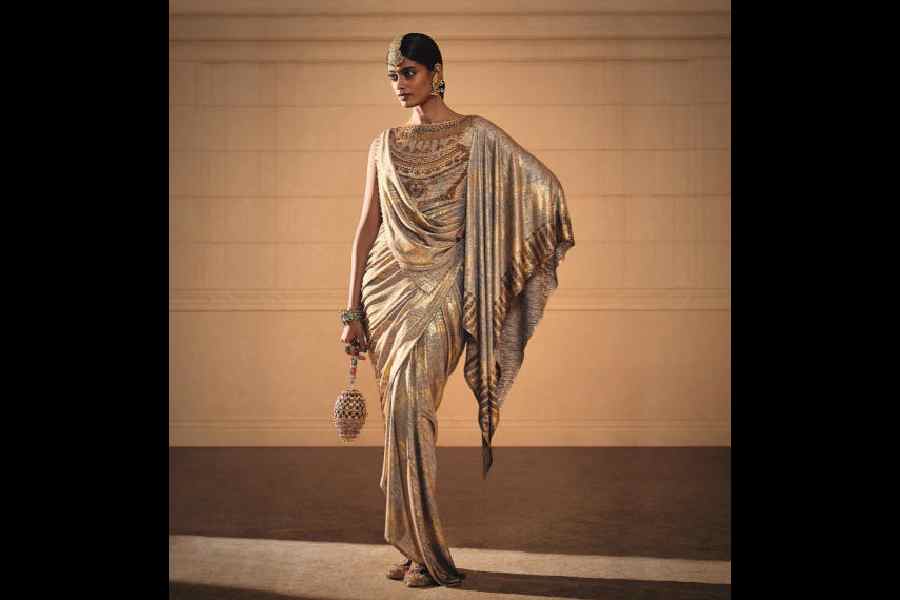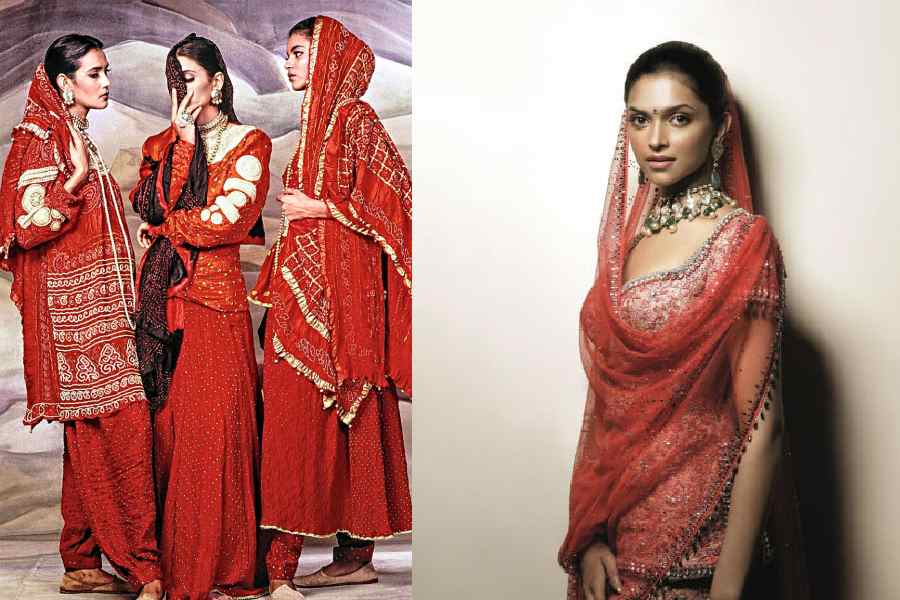Mahalaxmi Racecourse in Mumbai was in for a surreal surprise on the evening of November 16. A couple of chock-a-block wooden benches and multitudes of others standing behind those benches waited for the action to unfold. A couple of performers in monkey costumes created the initial stir, taking the audience by surprise. We hadn’t seen a show like this. And then walked in the ethereal Mehr Jesia. Kathakali and Kathiawari dancers, stilt walkers, giant puppets, Chhau dancers and dhol artistes accompanied the models at various stages of the tableau. All dressed in Tarun Tahiliani, recreating a live leafing through of his Tarun Tahiliani: Journey To India Modern, a coffee-table book that was launched at Art Mumbai Fair, later in the evening. A nostalgia-laden 300-odd pages that was a journey into TT’s mind and the making of the brand as we know it today. Refined aesthetics, mind-boggling simplicity, charming romance and cool elegance marked the golden-rimmed pages. His creations from the late ‘80s and early ‘90s were way ahead of their time, so relevant even today, powered by a raw romance.

Tarun Tahiliani: Journey To India Modern
Co-authored by Tarun Tahiliani and Alia Allana and published by Roli Books in India and Thames & Hudson internationally, priced at Rs 5,995, it was Tarun’s nearly three decades of memories. Born to Admiral R.H. Tahiliani, Chief of Naval Staff, and Jaswanti Tahiliani, one of the first female engineers in Maharashtra, Tarun went to Doon School, Wharton Business School and Fashion Institute of Technology and co-founded Ensemble, the famed multi-designer store in Mumbai with wife Sailaja in 1987.
The book was a picturesque narration of how Tarun had integrated Indian crafts as a part of his design language over the years. We were enlightened to know he sold oil field equipment for a living and that he painted. Tarun’s first solo show was held in London in 1994 and he moved to Delhi, in 1995, the same year he launched his eponymous label. The book celebrated his milestone collections and his signature aesthetics like the chikankari, concept sari and corsets among others. A glossary of terms defining the various arts and crafts was most helpful.

Tarun Tahiliani
Tarun chatted with t2 on the making of the book and why Indian heritage was timeless.
How long has the book been in the making?
Remember when we had that 25-year party (in 2020)... the book kind of started then, the idea. And it kind of just fell by the wayside during Covid. Actually, it was monumental. In the ‘80s and ‘90s, we shot everything on transparency and we hadn’t been that particular about keeping (them) and things were lost. So, we had to get everything transferred and that in itself cost a fortune because it had to be calibrated, cleaned up and we had to go through the transparencies and then put it on digital. That took a long time.
We actually simplified the book. We had actually done many more textures, papers and transparencies, but it was making the book much more expensive and I wanted it to be accessible to fashion school. It’s not a book for the rich. It is a book to tell a story about how India influences me and I think that relevance has to go much further than just showing it to people who can afford anything and are lucky to be exposed to everything because that’s the messaging I was trying to put out. It’s not about royal India and cliches. It’s about a spirit we have in this country. A lot of our embroideries actually come from a lot of folk tradition.
Putting it together must have been nostalgia overload...
When we go to shoots there are 100 people and I say, listen guys, in the olden days we couldn’t afford anything. We could afford 10 transparencies... so we were careful and shot carefully and we created beautiful images. Now when we go to shoots, they take 6,000 images because it’s digital. You get a migraine looking at it. I tell them I don’t want to touch up. Also, we didn’t have stylists.

A signature Tarun Tahiliani drape
We had a lot of downtime and we looked at all the pictures. The whole opening section of chikans was inspired by what we did in 2003. It took me back to things that I did and forgot when this whole bridal madness happened in India. I think a lot of the designers started at one thing and then it became all bridal. While it’s okay, it also created ridiculous clothes that people can’t walk in.
You see the Kutch clothes based on the Kathiawari men and women. I always talk about drape... everything was wearable and by all ages of women and I want to go back to that. There was not one dot of embroidery. If I can take that to the world, that’ll be my contribution, not bridal costumes. It’s taken me back to things that actually excited me.
The book has stunning images from the late ‘80s and early ‘90s and they are still so relevant. Do you have those pieces with you?
Yeah, I had variations of those. That sari that came in the Kumbh collection, that’s the same piece from the archives. We draped it differently. Indian fashion is timeless. You can take your great-grandmother’s things and wear them. They wore it with a choli and today you might wear it with a corset. You want excitement and newness but follow the Western thing. That’s why what we have always done is sustainable. Please let’s go back to the backstory of who we are and the timelessness of the drape. That’s the only way we’ll get rid of fast fashion.
Sustainability means natural and you reuse things. We had a piece that was shot in 1989. Many of the things in the show were exact replicas, like a chikan shirt-pantsuit. The drapes also all came out of the archives. It’s only the things at the end which were from the current collections like the Pichwai.
Our style and class are timeless. ‘A thing of beauty is a joy forever’. We just need to go back and live by that principle.
We were blown away by your mother’s image!
She was one of the first female engineers in Mumbai and they had to build a toilet for her in VJTI (Veermata Jijabai Technological Institute) and she also modelled. I have got my zest and madness from her. Look at the cholis! This was in the ‘50s.
How have Sal ma’am and Tina Tahiliani Parikh (sister) influenced your aesthetics in how you dress women?
Well, because I have lived with these strong women, for me fashion is always something real. They all love fashion but fashion is a part of our lives and not the point of our lives. Tina was wearing something 15 years old that day. Sal was the one who had the idea of Ensemble. Behind every strong man, there is a stronger woman. I think these women are a testament to that. Sal is low-key and she tells me that she is not here to tell me what I want to hear, but what it is.
We were very broke and my salary was Rs 4,000 and Sal started modelling to pay the bills and she was cast in a Vimal sari campaign and Rohit Khosla was the stylist. We were in Jaipur shooting and that’s where the idea of Ensemble was born. We became the best of friends. He (Rohit Khosla) would come and stay with us and we lived in a one-bedroom flat. That was fun. We were young. That’s how we Indians are, warm with each other.
Sal grew up in America and we’d look at these amazing things abroad which were not available in India and (thought) why after 40 years of Independence are we giving our best product to the White man? There was no proper retail and we really believed that if we showed Indians what we were capable of, we have the best.
When Tina was at Stanford (University), she came to Maheshwar with Sally Holkar (co-founder, Rehwa Society) and she did a big report on disarticulated economies. The women who were weavers had stopped wearing Maheshwaris because they were all wearing polyester and because of that their engagement with their product had gone down, there was no further development. Everything became mechanical.

(l-r) Tarun Tahiliani's 1992 collection 'Fields of India', Deepika Padukone in Tarun Tahiliani
When you are engaged and live and wear with your product, it’s a constant R&D (research and development) in your life. We were losing that because we were taking cheap rejects.
Coming to the show, it was sheer magic...
Gautam Kalra styled the show and he went crazy for weeks. He was amazing. Gaurav Raina of Midival Punditz did the music and Ma Faiza did the after-party. We had village performers. I dressed the stilt walkers and the puppets. I liked the puppets because I looked like a midget next to them (laughs). There were also many underlying currents (laughs out loud)!
Saionee Chakraborty
Pictures courtesy: Tarun Tahiliani Archive and Tarun Tahiliani
